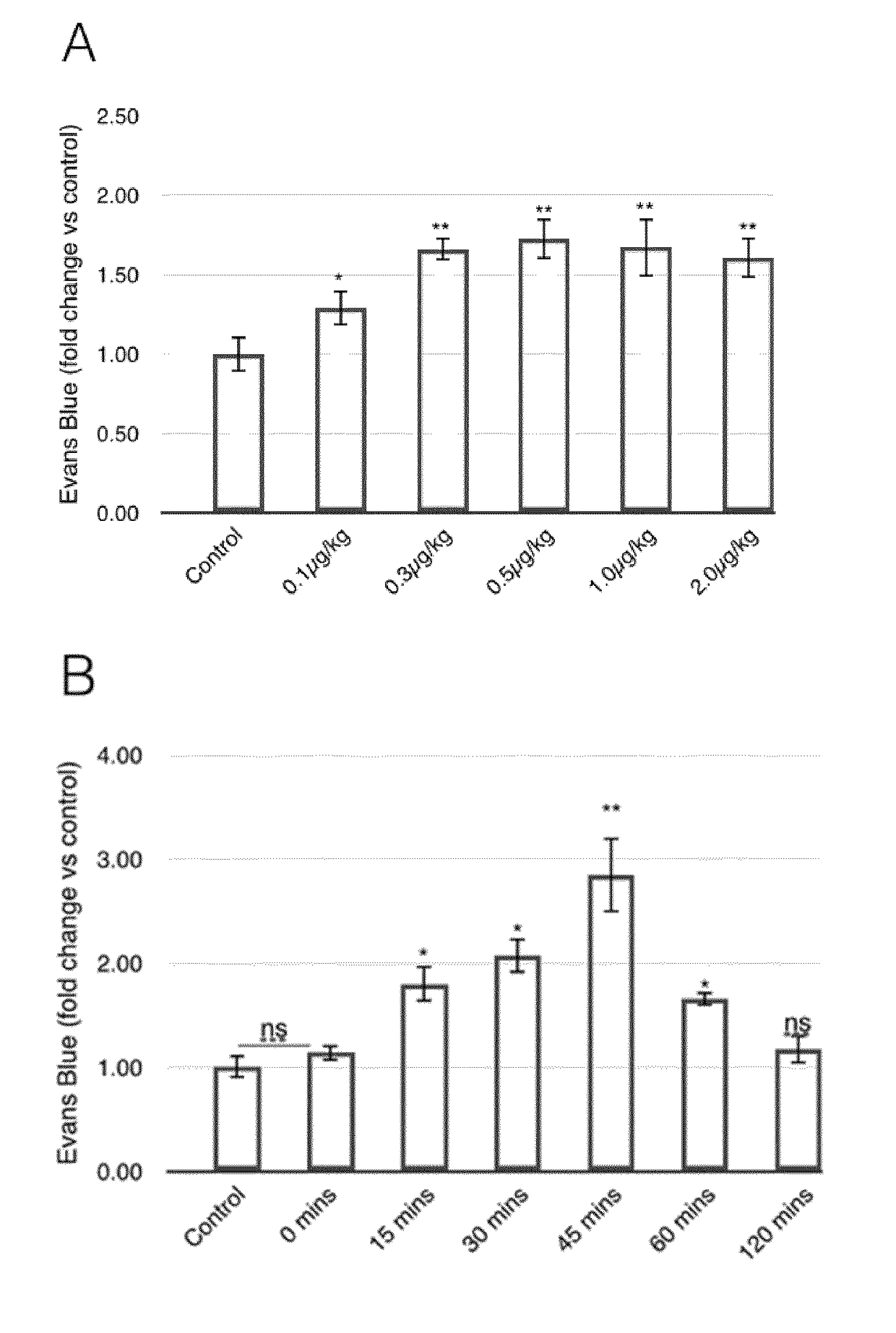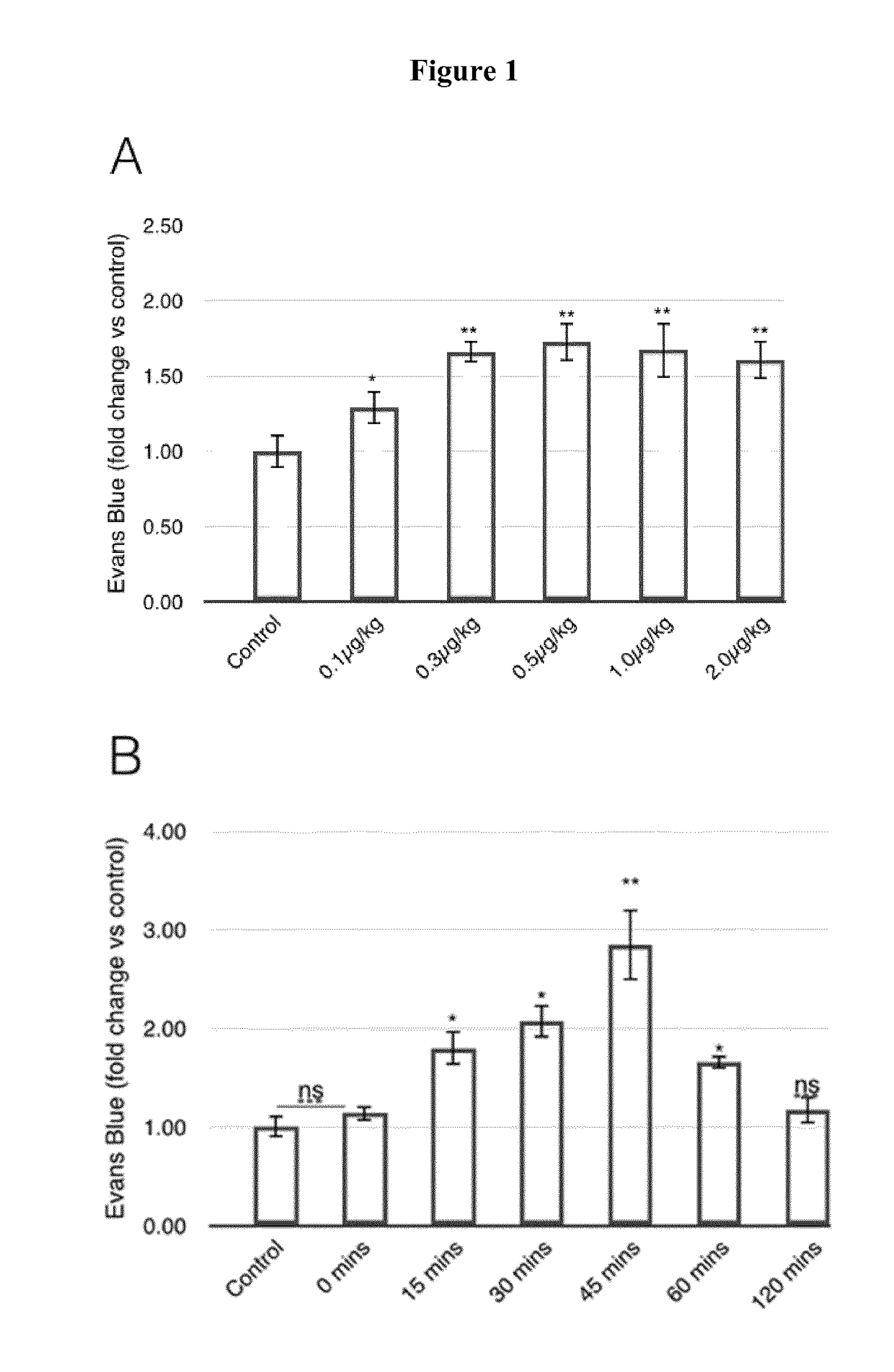Methods for enhancing permeability to blood-brain barrier, and uses thereof
a technology of bloodbrain barrier and permeability, which is applied in the direction of drug compositions, pharmaceutical active ingredients, peptide/protein ingredients, etc., can solve the problems of difficult treatment of many neurological disorders, death or impairment of mobility, agents to the brain, etc., and achieve the effect of facilitating the delivery of agents
- Summary
- Abstract
- Description
- Claims
- Application Information
AI Technical Summary
Benefits of technology
Problems solved by technology
Method used
Image
Examples
example 1
nced the Permeability of Blood-Brain Barrier in a Mouse Model
Materials and Methods
[0079](i) Determination of BBB Permeability by Evans Blue (EB) Extravasation
[0080]BBB permeability was quantitatively estimated by Evans Blue (Fluka). Evans Blue (2% or 4% v / v in saline, 4 ml / kg) was injected intravenously. For extravasation analysis, animals were perfused with 50 ml 0.9% saline (with 10 i.u. / ml heparin) to remove intravascular dye until colourless fluid was obtained from the arteries, kidney and liver. Animals were then sacrificed and the brain was weighed, homogenised in N,N-dimethylformamide (Sigma-Aldrich) (1 ml / 150 mg tissue weight), incubated for 18 hours at 55° C., and centrifuged (14000 rpm / 20 min). Dye supernatant was analysed by spectrophotometry at 620 nm. For MCAO model rats, the brain was divided into infarcted and non-infarcted sides and supernatants from both sides were measured.
[0081](ii) Determination of VEGF Action on BBB Permeability
[0082]Mice were divided into six g...
example 2
Treatment Enhanced Post-Stroke hMSC-Based Cell Therapy
[0100]Brain stroke, also known as cerebrovascular accident (CVA), is the rapid loss of brain function due to disturbance in the blood supply to the brain. There are two types of stroke: hemorrhagic stroke and ischemic stroke. The hemorrhagic stroke is resulted from the disruption of intracranial arteries and thereby causing acute intracranial haematoma. The ischemic stroke, also known as cerebral infarction, is brain cell death in an area of the brain where the blood flow is blocked, such as by thrombus or distal embolism. Currently, the two standard treatments for ischemic stroke are injection of thrombolytic agents and endovascular procedures, both of which aim to re-establish local blood flow and decrease the hypoxic damage to brain tissue as quickly as possible.
[0101]Mesenchymal stem cells (MSCs) are a heterogeneous population of multipotent stromal cells, capable of differentiating into osteoblasts, chondrocytes, and adipocy...
example 3
Treatment Delayed Brain Tumor Growth in Mice Treated with Anti-Cancer Agents and Improved GBM Mice Survival
[0108]Glioblastoma multiform (GBM), also known as grade IV glioma, is the most common and most aggressive type of malignant tumour of brain tissue. The current standard for treatment is a combination of surgical resection, radiotherapy and chemotherapy. GBM is highly invasive and infiltrates healthy tissue, and most patients are diagnosed when the tumor is too large and disseminated for surgical removal. Therefore, even when undergoing modern treatments, the median survival rate for GBM patients is 12-15 months after commencing treatment, one of the lowest 5-year survival rates of all human cancers. Since surgical resection is rarely successful, drug therapies are the most promising area for improvement. Suitable anti-cancer drugs already exist; however, the BBB interrupts drug delivery to brain tumors. Patel et al., J Neurooncol. 61(3): 203-207; 2003.
[0109]This study investiga...
PUM
| Property | Measurement | Unit |
|---|---|---|
| sizes | aaaaa | aaaaa |
| sizes | aaaaa | aaaaa |
| sizes | aaaaa | aaaaa |
Abstract
Description
Claims
Application Information
 Login to View More
Login to View More - R&D
- Intellectual Property
- Life Sciences
- Materials
- Tech Scout
- Unparalleled Data Quality
- Higher Quality Content
- 60% Fewer Hallucinations
Browse by: Latest US Patents, China's latest patents, Technical Efficacy Thesaurus, Application Domain, Technology Topic, Popular Technical Reports.
© 2025 PatSnap. All rights reserved.Legal|Privacy policy|Modern Slavery Act Transparency Statement|Sitemap|About US| Contact US: help@patsnap.com



